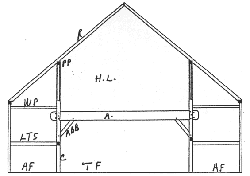|
The Wortendyke New World Dutch Barn By Robert L. Cohen |
![]()
The Wortendykes settled in the area in 1735 when Frederick Wortendyke, Sr. purchased the acreage from Hendrick Vanderlinda. The Wortendyke family maintained the land as a working farm from 1735 to 1851 when the farm was sold. It remained an ongoing farm owned by the Wortendykes for over 115 years - from before the French and Indian War until nine years before the start of the Civil War. The Wortendyke Barn Museum's exhibits include handmade 18th and 19th century farm implements and tools, the history of the Wortendyke family farm, and exhibits showing the agricultural history of Bergen County from the first settlers until the present. The Revolutionary War and its impact on the Wortendyke family is touched upon. The main feature of the museum is the barn building, an outstanding example of the vernacular architecture referred to as a "New World Dutch Barn." Wherever the Dutch settled along the Hackensack, Passaic, Raritan and Millstone Rivers and their tributaries, the heavy timber frames of these three-bayed, door-in-the-gable-end barns were raised. Other locations were along the Hudson and Mohawk Rivers, and Schoharie Creek in New York State. In the United Provinces a section of the barn included living quarters for the farm family whereas in the New World the barn and dwelling were separate. Possibly this was to lessen the danger of losing the barn to fire from the household heating and cooking operations, and/or because firewood was plentiful and the warmth of the livestock wasn't needed to augment the fireplace.
Dutch Barns were constructed of local timber, down to the wooden fasteners called trunnels or pegs. Due to the ravages of time and the advancements in agriculture that have taken place over the last century and a half in this area, there are only a few examples of this type of barn extant. The accompanying illustration shows the barn's timber frame construction. The H-frame with the heavy horizontal summer beam provided great strength. The Wortendyke Museum is open to the public from May through October on Wednesday and Sunday afternoons, and by appointment. You can find more information on the Museum at www.artcom.com.
Robert L. Cohen, holds a B.A. and advanced degrees from Rutgers University. He is the curator of the Wortendyke Dutch Barn Farm Museum and the Demarest House Museum at New Bridge Landing Historic Park, River Edge, NJ. Mr. Cohen's articles have appeared in de Halve Maen and other scholarly journals.
The following is a useful bibliography on Dutch barns. You can also refer to de Halve Maen, journal of the Holland Society of New York, 1924-Present, for articles on early Dutch culture in New Jersey.
|
![]()


